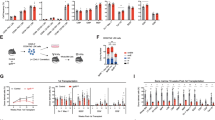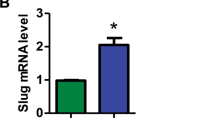Abstract
Philadelphia chromosome-positive (Ph+) chronic myeloid leukemia (CML) induced by the BCR-ABL oncogene is believed to be developed from leukemic stem cells (LSCs), and we have previously shown in mice that LSCs for CML express the same cell surface markers that are also expressed on normal hematopoietic stem cells (HSCs). Although the inhibition of BCR-ABL kinase activity by imatinib is highly effective in treating human Ph+ CML in chronic phase, it is difficult to achieve molecular remission of the disease, suggesting that LSCs remain in patients. In this study, we find that following imatinib treatment, LSCs not only remained but also accumulated increasingly in bone marrow of CML mice. This insensitivity of LSCs to imatinib was not because of the lack of BCR-ABL kinase inhibition by imatinib, and proliferating leukemic cells derived from LSCs were still sensitive to growth inhibition by imatinib. These results identify an LSC survival pathway that is not inhibited by imatinib. Furthermore, we show that β-catenin in the Wnt signaling pathway is essential for survival and self-renewal of LSCs, providing a new strategy for targeting these cells.
This is a preview of subscription content, access via your institution
Access options
Subscribe to this journal
Receive 12 print issues and online access
$259.00 per year
only $21.58 per issue
Buy this article
- Purchase on Springer Link
- Instant access to full article PDF
Prices may be subject to local taxes which are calculated during checkout




Similar content being viewed by others
References
Druker BJ, Talpaz M, Resta DJ, Peng B, Buchdunger E, Ford JM et al. Efficacy and safety of a specific inhibitor of the BCR-ABL tyrosine kinase in chronic myeloid leukemia. N Engl J Med 2001; 344: 1031–1037.
Hughes TP, Kaeda J, Branford S, Rudzki Z, Hochhaus A, Hensley ML et al. Frequency of major molecular responses to imatinib or interferon alfa plus cytarabine in newly diagnosed chronic myeloid leukemia. N Engl J Med 2003; 349: 1423–1432.
O'Brien SG, Guilhot F, Larson RA, Gathmann I, Baccarani M, Cervantes F et al. Imatinib compared with interferon and low-dose cytarabine for newly diagnosed chronic-phase chronic myeloid leukemia. N Engl J Med 2003; 348: 994–1004.
Lin F, Drummond M, O'Brien S, Cervantes F, Goldman J, Kaeda J . Molecular monitoring in chronic myeloid leukemia patients who achieve complete cytogenetic remission on imatinib. Blood 2003; 102: 1143.
Drummond MW, Lush CJ, Vickers MA, Reid FM, Kaeda J, Holyoake TL . Imatinib mesylate-induced molecular remission of Philadelphia chromosome-positive myelodysplastic syndrome. Leukemia 2003; 17: 463–465.
Hu Y, Liu Y, Pelletier S, Buchdunger E, Warmuth M, Fabbro D et al. Requirement of Src kinases Lyn, Hck and Fgr for BCR-ABL1-induced B-lymphoblastic leukemia but not chronic myeloid leukemia. Nat Genet 2004; 36: 453–461.
Wolff NC, Ilaria Jr RL . Establishment of a murine model for therapy-treated chronic myelogenous leukemia using the tyrosine kinase inhibitor STI571. Blood 2001; 98: 2808–2816.
Graham SM, Jorgensen HG, Allan E, Pearson C, Alcorn MJ, Richmond L et al. Primitive, quiescent, Philadelphia-positive stem cells from patients with chronic myeloid leukemia are insensitive to STI571 in vitro. Blood 2002; 99: 319–325.
Marley SB, Deininger MW, Davidson RJ, Goldman JM, Gordon MY . The tyrosine kinase inhibitor STI571, like interferon-alpha, preferentially reduces the capacity for amplification of granulocyte-macrophage progenitors from patients with chronic myeloid leukemia. Exp Hematol 2000; 28: 551–557.
Hu Y, Swerdlow S, Duffy TM, Weinmann R, Lee FY, Li S . Targeting multiple kinase pathways in leukemic progenitors and stem cells is essential for improved treatment of Ph+ leukemia in mice. Proc Natl Acad Sci USA 2006; 103: 16870–16875.
Moon RT, Kohn AD, De Ferrari GV, Kaykas A . WNT and beta-catenin signalling: diseases and therapies. Nat Rev Genet 2004; 5: 691–701.
Korinek V, Barker N, Morin PJ, van Wichen D, de Weger R, Kinzler KW et al. Constitutive transcriptional activation by a beta-catenin-Tcf complex in APC−/− colon carcinoma. Science 1997; 275: 1784–1787.
Morin PJ, Sparks AB, Korinek V, Barker N, Clevers H, Vogelstein B et al. Activation of beta-catenin-Tcf signaling in colon cancer by mutations in beta-catenin or APC. Science 1997; 275: 1787–1790.
Rubinfeld B, Robbins P, El-Gamil M, Albert I, Porfiri E, Polakis P . Stabilization of beta-catenin by genetic defects in melanoma cell lines. Science 1997; 275: 1790–1792.
Rask K, Nilsson A, Brannstrom M, Carlsson P, Hellberg P, Janson PO et al. Wnt-signalling pathway in ovarian epithelial tumours: increased expression of beta-catenin and GSK3beta. Br J Cancer 2003; 89: 1298–1304.
Uematsu K, He B, You L, Xu Z, McCormick F, Jablons DM . Activation of the Wnt pathway in non-small cell lung cancer: evidence of dishevelled overexpression. Oncogene 2003; 22: 7218–7221.
Reya T, Duncan AW, Ailles L, Domen J, Scherer DC, Willert K et al. A role for Wnt signalling in self-renewal of haematopoietic stem cells. Nature 2003; 423: 409–414.
Willert K, Brown JD, Danenberg E, Duncan AW, Weissman IL, Reya T et al. Wnt proteins are lipid-modified and can act as stem cell growth factors. Nature 2003; 423: 448–452.
Uchida N, Sutton RE, Friera AM, He D, Reitsma MJ, Chang WC et al. HIV, but not murine leukemia virus, vectors mediate high efficiency gene transfer into freshly isolated G0/G1 human hematopoietic stem cells. Proc Natl Acad Sci USA 1998; 95: 11939–11944.
Akashi K, Traver D, Miyamoto T, Weissman IL . A clonogenic common myeloid progenitor that gives rise to all myeloid lineages. Nature 2000; 404: 193–197.
Manz MG, Miyamoto T, Akashi K, Weissman IL . Prospective isolation of human clonogenic common myeloid progenitors. Proc Natl Acad Sci USA 2002; 99: 11872–11877.
Kondo M, Wagers AJ, Manz MG, Prohaska SS, Scherer DC, Beilhack GF et al. Biology of hematopoietic stem cells and progenitors: implications for clinical application. Annu Rev Immunol 2003; 21: 759–806.
Domen J, Weissman IL . Hematopoietic stem cells need two signals to prevent apoptosis; BCL-2 can provide one of these, Kitl/c-Kit signaling the other. J Exp Med 2000; 192: 1707–1718.
Orkin SH, Zon LI . Hematopoiesis and stem cells: plasticity versus developmental heterogeneity. Nat Immunol 2002; 3: 323–328.
Lessard J, Sauvageau G . Bmi-1 determines the proliferative capacity of normal and leukaemic stem cells. Nature 2003; 423: 255–260.
Coluccia AM, Vacca A, Dunach M, Mologni L, Redaelli S, Bustos VH et al. Bcr-Abl stabilizes beta-catenin in chronic myeloid leukemia through its tyrosine phosphorylation. EMBO J 2007; 26: 1456–1466.
Jamieson CH, Ailles LE, Dylla SJ, Muijtjens M, Jones C, Zehnder JL et al. Granulocyte-macrophage progenitors as candidate leukemic stem cells in blast-crisis CML. N Engl J Med 2004; 351: 657–667.
Li S, Ilaria Jr RL, Million RP, Daley GQ, Van Etten RA . The P190, P210, and p230 forms of the BCR/ABL oncogene induce a similar chronic myeloid leukemia-like syndrome in mice but have different lymphoid leukemogenic activity. J Exp Med 1999; 189: 1399–1412.
Roumiantsev S, de Aos IE, Varticovski L, Ilaria RL, Van Etten RA . The src homology 2 domain of Bcr/Abl is required for efficient induction of chronic myeloid leukemia-like disease in mice but not for lymphoid leukemogenesis or activation of phosphatidylinositol 3-kinase. Blood 2001; 97: 4–13.
Brault V, Moore R, Kutsch S, Ishibashi M, Rowitch DH, McMahon AP et al. Inactivation of the beta-catenin gene by Wnt1-Cre-mediated deletion results in dramatic brain malformation and failure of craniofacial development. Development 2001; 128: 1253–1264.
Li S, Couvillon AD, Brasher BB, Van Etten RA . Tyrosine phosphorylation of Grb2 by Bcr/Abl and epidermal growth factor receptor: a novel regulatory mechanism for tyrosine kinase signaling. EMBO J 2001; 20: 6793–6804.
Shah NP, Tran C, Lee FY, Chen P, Norris D, Sawyers CL . Overriding imatinib resistance with a novel ABL kinase inhibitor. Science 2004; 305: 399–401.
Shah NP, Nicoll JM, Nagar B, Gorre ME, Paquette RL, Kuriyan J et al. Multiple BCR-ABL kinase domain mutants confer polyclonal resistance to the tyrosine kinase inhibitor imatinib (STI571) in chronic phase and blast crise chronic myeloid leukemia. Cancer Cell 2002; 2: 117–125.
Zhao C, Blum J, Chen A, Kwon HY, Jung SH, Cook JM et al. Loss of beta-catenin impairs the renewal of normal and CML stem cells in vivo. Cancer Cell 2007; 12: 528–541.
Acknowledgements
We thank Stephen B Sampson for critical reading of the manuscript, and Patricia Cherry for the secretarial assistance. This work is supported by the grants from the Leukemia and Lymphoma Society and the National Institutes of Health (R01-CA114199, R01-CA122142) to SL. SL is a Scholar of the Leukemia and Lymphoma Society.
Author information
Authors and Affiliations
Corresponding author
Additional information
Supplementary Information accompanies the paper on the Leukemia website (http://www.nature.com/leu)
Rights and permissions
About this article
Cite this article
Hu, Y., Chen, Y., Douglas, L. et al. β-Catenin is essential for survival of leukemic stem cells insensitive to kinase inhibition in mice with BCR-ABL-induced chronic myeloid leukemia. Leukemia 23, 109–116 (2009). https://doi.org/10.1038/leu.2008.262
Received:
Revised:
Accepted:
Published:
Issue Date:
DOI: https://doi.org/10.1038/leu.2008.262
Keywords
This article is cited by
-
RNA binding protein IGF2BP1 synergizes with ETV6-RUNX1 to drive oncogenic signaling in B-cell Acute Lymphoblastic Leukemia
Journal of Experimental & Clinical Cancer Research (2023)
-
A conserved ZFX/WNT3 axis modulates the growth and imatinib response of chronic myeloid leukemia stem/progenitor cells
Cellular & Molecular Biology Letters (2023)
-
Developing therapeutic approaches for chronic myeloid leukemia: a review
Molecular and Cellular Biochemistry (2023)
-
Chronic myeloid leukemia stem cells
Leukemia (2019)
-
Stem cell fate in cancer growth, progression and therapy resistance
Nature Reviews Cancer (2018)



